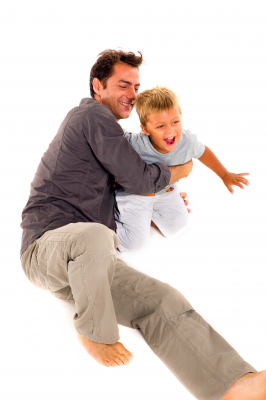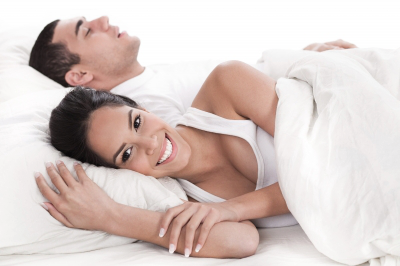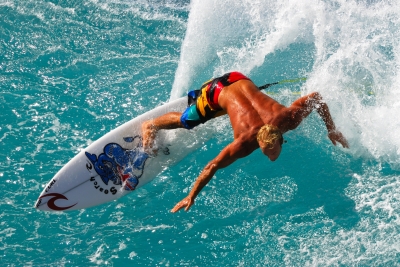WHAT IS ORTHOKERATOLOGY?
Ortho What? Orthokeratology or Ortho-K for short may sound dramatic but it is quite simple. As in Orthodontics and Orthopedics, the 'Ortho' in Ortho-K is for correction.Father playing with his son
Orthodontics corrects teeth. Orthopedics corrects skeletal injuries.
Orthokeratology corrects the cornea (front surface of the eye). 
Ortho-K is a safe, non-surgical and reversible eye treatment procedure in which specially designed contact lens devices are used to gently and gradually reshape the cornea of the eye while you sleep.
The Ortho-k contact lens devices are only worn during normal sleeping hours. On waking, the contact lenses are removed. The reshaped corneal surface allows clear and natural vision for the rest of the waking day without the need for prescription glasses or contact lenses.
In June 2002 the American Food and Drug Administration (FDA) granted approval to overnight Orthokeratology stating it to be a safe and controlled procedure. Orthokeratology is ideal for children and adults with prescriptions ranging from -1.00 to -10.00 Diopters of Myopia and from +1.00 to +5.00 Diopters of Hyperopia. Currently only low to moderate amounts of Astigmatism can be corrected.
New designs are currently being tested which will allow for the correction of high Astigmatism, Presbyopia and Post-LASIK (refractive surgery) patients who still have some residual Myopia or irregular treatment areas.
HOW DOES IT WORK?
While you sleep, the lens molds the epithelial cells of the cornea using fluid forces to conform the cornea to the lens’ reverse geometry design. This produces a flatter central cornea and steepens the peripheral cornea correcting the nearsightedness.
Smiling in bed with GOV Orthokeratology lensesIn the case of Hyperopia and Presbyopia the cornea is conformed to the lens’ double reverse geometry design steepening the central cornea and flattening the peripheral cornea, correcting the farsightedness.
Improvements can usually be seen the next day with the procedure stabilising after a week. With the high minus powers (correcting myopia over -6.00D) the procedure takes from 2 to 4 weeks to stabilise. Ortho-k does not make any permanent changes to the eye surface. Your eyes will revert to their former state within 1 to 4 weeks as soon as you stop using the lenses.
The risks involved with the treatment are the same risk as for any contact lens wearers ranging from allergies to bacterial infections due to poor maintenance and hygiene.
The lenses are surprisingly comfortable to wear and most people comment that they forget they have lenses in their eyes after the 1st night of sleeping with the lenses.
WHO WILL BENEFIT FROM ORTHO-K?
Ortho-k holds particular appeal for: 
SurfPeople who participate in sport, especially contact and water sports like rugby, soccer, martial arts, swimming, surfing, kite surfing, skydiving, etc.
People working in dusty or dirty environments or other vocations that can cause problems for regular contact lens or spectacle wear like diving industry, construction, law enforcement, firefighting, etc.
People who are contact lens intolerant due to dry eyes, allergies or environmental factors.
Children. Apart from improving their vision, children and especially teenagers benefit from the improved self-esteem, the ability to play all sports, and the ability to wear designer sunglasses. Parents don’t have to worry about contact lenses, because they’re left at home where it can’t be lost or damage.
Myopia control. Recent research is showing more and more that Orthokeratology has the ability to retard the progression of myopia in young children.
In short Ortho-k works best for people who don't want to wear glasses or contact lenses all day, but don't mind wearing contact lenses while they sleep.
Ortho-k is also not for everyone. You must have a healthy eye that is free of any corneal scarring and pathology. The same corneal health criteria that holds true for any of the refractive error surgery corrections like LASIK, holds true for Ortho-k. The only exception is corneal thickness. Orthokeratology is corneal thickness independent which means people who were not good candidates for LASIK due to too thin corneas can safely attempt Ortho-K
Most people's reaction when they first learn of Orthokeratology is one of disbelief and skepticism. The reason for this is that Ortho-K is not well known publicly due to the small number of eye care professionals who practice Ortho-K and routinely offer it as a vision correction method to their patients. It is currently estimated that only 5% of the worlds' contact lens practitioners are trained and qualified to perform Orthokeratology. It is however expected that this number will increase in the coming years. Orthokeratology is becoming more well known and more practitioners are convinced of Ortho-K, as the procedure now has a well proved tract record with over a decade's worth of clinical data backed up with strong scientific research.
If you have any further questions regarding Orthokeratology, not answered on this site, we would really like to hear from you. Please feel free to post your questions or suggestions on the forum or alternatively e-mail us.